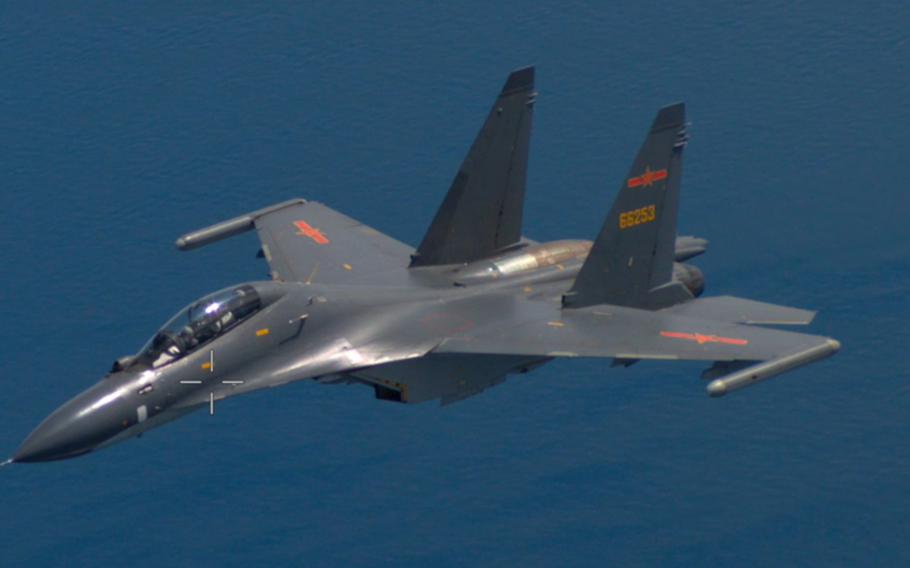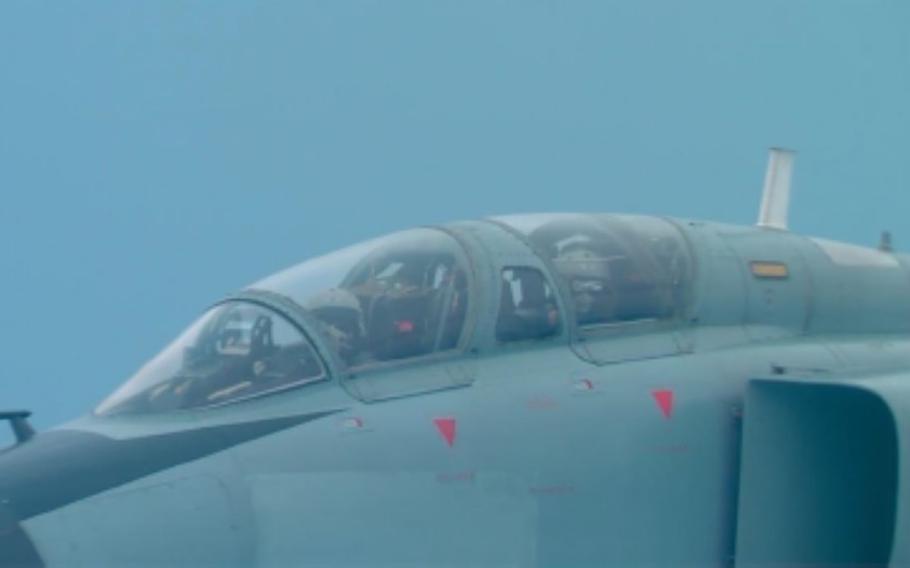
Images and video newly released by the Defense Department capture a Chinese fighter jet in the course of conducting a coercive and risky intercept June 23, 2022, against a U.S. asset in the South China Sea, including by approaching a distance of just 40 feet before repeatedly flying above and below the U.S. aircraft and flashing its weapons. After the U.S. operator radioed the Chinese fighter jet, the Chinese pilot responded using explicit language, including an expletive. (Defense Department)
WASHINGTON — China is ramping up production of nuclear weapons, increasing pressure on Taiwan and becoming more distrustful of other nations, the Pentagon revealed Thursday in its annual report on the strength of the Chinese military.
“This report illustrates the importance of meeting the pacing challenge presented by [China’s] increasingly capable military,” the Defense Department said in an executive summary of the report, formally known as the Military and Security Developments Involving the People’s Republic of China. “As China seeks to achieve ‘national rejuvenation’ by its centenary in 2049, Chinese Communist Party leaders view a modern, capable and ‘world-class’ military as essential to overcoming what Beijing sees as an increasingly turbulent international environment.”
The Pentagon report, which studies developments in China in 2022 and 2023, states some of the top concerns involve Chinese efforts to expand its national power, strengthen its nuclear weapons, deepen a “no limits” partnership with Russia and resist direct communications with the U.S. military. The report outlines various destabilizing moves China has made recently in the Indo-Pacific region, a vast portion of the world that includes three dozen countries and the Pacific and Indian oceans.
“In 2022, [China] adopted more dangerous, coercive and provocative actions in the Indo-Pacific,” according to a Defense Department fact sheet on the report. “For example, between the fall of 2021 and fall of 2023, the United States documented more than 180 instances of [Chinese] coercive and risky air intercepts against U.S. aircraft in the region.”
On Tuesday, the Pentagon released dozens of images and videos documenting some of those incidents, which included Chinese fighter jets flying dangerously close to U.S. planes. Some Chinese aircraft got so close that the pilots are clearly seen in the images.
Part of China’s recent destabilizing moves in the Indo-Pacific, the report states, involve ratcheting up pressure against Taiwan, an island that Beijing considers a breakaway territory. Chinese leaders, including President Xi Jinping, have repeatedly stated a desire to unify with Taiwan, a move that U.S. officials believe would almost certainly require a military invasion. Throughout 2022, China’s military increased “provocative” actions in and around the Taiwan Strait, including ballistic missile overflights across the island, sending more Chinese aircraft into Taiwanese airspace and simulating large-scale blockade and firepower strike operations, according to the report.

Images newly released by the Defense Department capture a Chinese fighter jet while conducting a coercive and risky intercept on June 8, 2022, against a U.S. asset in the East China Sea. Over the course of five hours, four Chinese aircraft conducted this intercept, including by approaching within 40 feet and taking pictures of the U.S. plane. (Defense Department )
The report also includes concerns by U.S. military commanders that China might be eyeing the late 2020s as a time to try and unify with Taiwan. The Chinese government is aiming to finish modernizing its military by 2027, which could make it a “more credible military tool” for Taiwan unification efforts.
“At the 20th Party Congress in 2022, Xi Jinping repeated … that China seeks peaceful unification with Taiwan but would never renounce the use of force as an option,” the fact sheet states.
Many of China’s destabilizing efforts are based on a belief in Beijing that much of the international community is working to isolate and suppress the communist country.
“Beginning [in] late 2022, Beijing launched a diplomatic ‘charm offensive’ targeting European countries in an apparent effort to improve perceptions of Beijing following years of ‘wolf warrior’ diplomacy and COVID isolation,” according to the report’s summary. “In March 2023, Xi Jinping told [Chinese] delegates … that ‘Western countries led by the United States have implemented comprehensive containment, encirclement and suppression against us, bringing unprecedented severe challenges to our country’s development.’”
That distrust has led China to avoid direct communication with the U.S. military, the report states. Beijing’s military “largely denied, canceled and ignored” attempted bilateral military engagements in 2022 and 2023 and other U.S. “requests for communication at multiple levels.” A senior defense official who spoke on condition of anonymity said Wednesday that the Chinese spy balloon that floated across the entire United States earlier this year is a great example of why such communication is important.
“The key takeaway from the entire incident, from my perspective, is that it really highlighted the critical need for open and consistent military-to-military communication at all levels,” the official said. “We did not have it during that incident, because [China] declined some of the requests we put forward.”
The Chinese balloon was spotted in late January near U.S. airspace in Alaska, and it continued on a southward path that later took it into Canada and again into U.S. airspace in northern Idaho in early February. Not wanting to shoot the large airship down over populated areas, U.S. officials waited for the balloon to leave the East Coast off South Carolina, and an F-22 fighter jet shot it down on Feb. 4.
U.S. officials said during the ordeal that the balloon was about 200 feet tall and carried a payload beneath it that was roughly the size of three school buses that contained surveillance materials. The incident spurred new concerns about the lengths China was willing to go to spy on the United States.
“We did take some precautions to minimize what intelligence the balloon could collect,” the senior defense official said. “It’s pretty clear, I think, that a lot of these high-altitude systems are … intended to support [Chinese military] requirements.”
Another concern raised by the Pentagon report is an apparent increase in China’s production of nuclear warheads. Beijing had more than 500 operational nuclear warheads by mid-2023 and is on pace to have more than 1,000 by the end of the 2020s, according to the Pentagon.
“It does put them on track to exceed previous projections,” the senior defense official said. “This obviously raises a lot of concerns for us. What we would really like to see is for them to be more transparent about their nuclear buildup and also to see some greater willingness on their part to discuss these strategic stability and risk reduction issues with us.”
Other findings in the China military power report:
Russia’s war in Ukraine caught China by surprise, and it was forced to react to the largest military conflict in Europe since World War II. As a result, China will probably seek to balance its partnership with Russia with avoiding economic backlash.
China wants to strengthen its armed forces into a world-class military by the end of 2049, the year the country celebrates its 100th anniversary. It considers this an “essential element” to become a “great modern socialist country.”
China’s military is studying “multi-domain precision warfare” to use data and artificial intelligence to find and attack vulnerabilities in U.S. operational systems.
China has the largest navy in the world with more than 370 ships and submarines, including a sophisticated new aircraft carrier that was launched last year.
China is developing new intercontinental ballistic missile systems that will significantly improve its nuclear missile forces and require ongoing production of nuclear warheads.
The Chinese military is “aggressively developing” capabilities to allow Beijing to deter or defeat third-party intervention in the Indo-Pacific region.
China is trying to restrict the United States from having a presence in the East and South China Sea regions, two waterways of which China claims disputed ownership.
In 2022, China probably finished building three new solid-propellant silo fields consisting of at least 300 new ICBM silos. At least some of those silos now have missiles in them.
The U.S. cannot verify China is abiding by the 1997 Chemical Weapons Convention regarding its research on pharmaceutical-based agents and toxins with possible military applications.